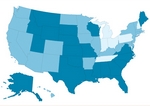business
Electronic medical records: What your data can tell you
■ Data analysis will help your practice achieve meaningful use, qualify as part of an accountable care organization, and identify at-risk patients or inefficient business practices.
- WITH THIS STORY:
- » Data requirements
- » The more codes there are, the more data to analyze
- » External links
One of the perceived advantages of electronic medical records is that physicians will have a wealth of information that can help them gain greater insight about patients.
The process of gathering and examining this information is called data analytics. For practices that are applying for federal bonuses for meaningful use of technology, or planning to work with accountable care organizations, analytics will be critical for proving that a practice is doing well enough to earn a bonus.
But even a practice that isn't participating in these programs can use analytics to get a solid, fact-based snapshot of how it is performing. Analytics can show physicians how similar chronic-care patients are faring, or show common threads among patients, or even help a practice identify expansion opportunities. And with more health plans offering performance-based pay, being able to collect data can help a practice prove its case for a better bonus.
"Apart from the moral and ethical imperative to do what is the best and the safest and the most effective treatments for patients ... physicians are also businessmen," said Ahmed F. Ghouri, MD, co-founder and chief medical officer of Anvita Health, a health care analytics firm based in San Diego. Clients include health plans, pharmacy benefit managers, disease management companies and physicians. "They're going to need analytics to be more successful, because they're going to need tools to keep patients from coming back to the hospital and to keep them healthy. They'll make more money by doing that," Dr. Ghouri said
A practice could pore through paper charts, but you need an EMR system to provide ways to search and organize patient data. The easier it is to collect and analyze data, the easier to use that data, whether by reaching out to at-risk patients or instituting changes to make a practice more efficient and financially sound.
The ultimate goal: seeing the forest of your patient population through the trees of your individual appointments.
Getting started: What to find
Before running a search, experts say physicians must ask themselves: What do I want to know?
The first part of analytics is collecting the data. And what a practice collects could be dictated by outside forces.
Under meaningful use rules, physicians must collect data such as patients' smoking status, health problems, medications, symptom surveillance and immunization. Some data collection is optional, at least for stage 1 of meaningful use. Physicians can earn bonuses of up to $44,000 from the Medicare program, or up to $63,750 from Medicaid for installing and using a certified EMR system.
The Office of the National Coordinator, the Centers for Medicare & Medicaid Services division overseeing the meaningful use program, has made it clear that the data that are optional for stage 1 will be required for stage 2 and beyond, although the second-stage requirements are not yet set.
In addition, in proposed regulations for CMS' Medicare Shared Savings Program for Accountable Care Organizations, health care organizations that align themselves as part of an ACO will be required to collect certain data. ACOs also are expected to have close ties with meaningful use criteria. Proposed ACO rules require that at least 50% of primary care physicians in the ACO be meaningful EMR users.
With the data in hand, physicians might be required by their ACO, for instance, to run reports on their diabetic patients to track their health and their health costs.
But physicians don't need prodding from an ACO to collect and run data.
Marc Holland, vice president of market research at HIMSS Analytics, said most practice management systems and EMRs, especially those certified to meet stage 1 meaningful use, allow for rudimentary analyses of data, such as creating reports of all the patients with a particular condition, or patients within a particular demographic.
Depending on the type of EMR a practice is using, it automatically might generate predefined reports that can be accessed by clicking on a file within the EMR.
Most EMRs also will have a function that allows a query or data sorting to display information for analysis. Examples include a list of all diabetic patients or a list of all patients within a certain age range.
Data analytics would be used to identify at-risk patients to assess their needs and identify if those needs are being met, experts said. For example, Prevea Health, a health care system in Green Bay, Wis., conducted a study to measure the effectiveness of analyzing patient data to identify possible at-risk diabetic and hypertensive patients and to reach out to them.
"Having the ability to run reports that sit on someone's desk does no one any good," said Ashok Rai, MD, CEO of Prevea Health of Green Bay, Wis. Organizations must be able to take action on that data, he said. And the more immediate that action, the better the results.
Next step: what to do with the data
Prevea used analytics to identify diabetic patients who had not had a hemoglobin A1c test in at least six months and hypertensive patients who had not had a systolic blood pressure reading in the same time frame. The system identified the patients, then flagged the ones who were considered noncompliant. Once those patients were identified, an automated phone call asked them to come in for a checkup.
The organization found in a later analysis that those patients who received the calls were about twice as likely as those who did not receive them to come in for a wellness visit and undergo the necessary tests. Results of the study were published December 2010 in the Journal of Population Health Management.
Holland used the example of a Washington, D.C, hospital at which an emergency physician noticed a spike in patients with gastric problems over 24 hours. Using data from the hospital -- as well as data from hospitals and physician practices that belonged to the same affiliated health information exchange network -- the doctor was able to query the number of patients from across that network who presented with similar gastric problems.
Using that data, investigators were able to identify a food poisoning outbreak and even identified a convenience store and a spoiled batch of deli meat as the source.
Similar analysis could identify areas for practice expansion or research, experts say. For instance, physicians could query the number of overweight patients in a community for purposes of launching support groups or creating nutritional counseling services.
"The ability to have a software agent in the background monitoring this kind of data and looking for patterns, and the ability to highlight to a human being what the software senses to be an unusual pattern, has tremendous value," Holland said.
The future: the evolution of analytics
Some additional analytic tools physician practices may want to adopt can be built for a few hundred dollars depending on the depth and complexity the practice wants, Holland said. Tools also may depend on whether the practice plans to use only its own data or pull from other sources, such as other health information exchange participants, and how outside data are made available.
Data analytics can be used by small practices, but experts said it works even better if those practices have access to information beyond their walls, such as the example Holland gave about how a large network was used to identify a food poisoning outbreak. That way, physicians have a larger sample size to examine if necessary.
As more health care organizations adopt EMRs, and more health information exchanges are formed, Holland said, there will be a much wider set of data to analyze and more ways for health care organizations to use those data.
Health care organizations should start planning for future analytics so the technical and logistical groundwork can be laid, said Dr. Ghouri from Anvita Health. He said it's not practical for an organization to decide on doing this type of activity then go live with it in 30 days.
Regardless of whether a practice plans to participate in the meaningful use or ACO incentive plans, experts said, the government has made clear that physicians eventually will need analytics to increase revenue and improve quality.
HIMSS Analytics Vice President of Market Research Marc Holland died on April 16 after a brief illness, as this story was prepared for publication.












